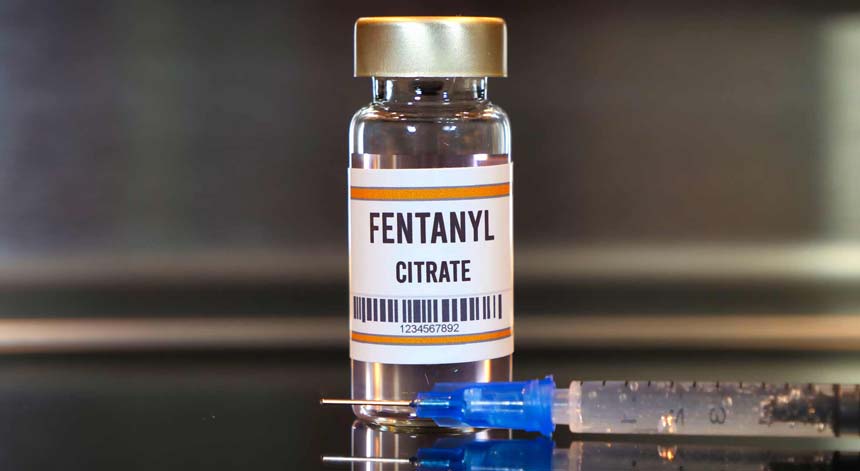A deadly killer is running rampant throughout the United States, becoming more rampant with each passing year. The terrifying fact is that in 2020, this menace claimed the lives of 69,000 people, nearly double from 2019, with a potential for another increase this year.
You’re wrong if you guessed common killers like pneumonia, flu, or suicide. The culprit responsible for nearly matching the number of deaths from diabetes in 2020 is fentanyl.
A grand total of 93,000 Americans died from opioids as a whole in 2020. These totals did manage to beat the number of diabetes and nearly matched the number of Alzheimer’s deaths. Suppose deaths continue to climb at the same rate. In that case, deaths from fentanyl will overtake those of stroke victims in a year, and eventually cancer and heart disease within a half-decade.
A New Leading Cause of Death for Americans
If this becomes a reality, fentanyl would be the number one cause of death in the United States. We haven’t opened this door of possibility yet, but we’re certainly close to knocking on it. The most surprising dynamic of this entire scenario is the fact that less than five years ago, most Americans couldn’t even tell you what fentanyl was.
What’s even more shocking is the tragic fact that most people who succumb to this deadly substance aren’t even aware they’re ingesting it before it kills them. Presently, most heroin sold on the streets is adulterated with fentanyl to increase profits.
Every day, millions of heroin users scramble to obtain their first dose of the illegal narcotic to avoid the nightmare of withdrawal. At this point, a great majority of the withdrawal is no longer centered around heroin. It has likely shifted to fentanyl because of the large amounts contained within the heroin supply that reaches the United States.
A significant reason why fentanyl continues to claim so many lives is the fear of withdrawal. The inability to face withdrawal alone and the lack of enough direction or support stop many users from entering recovery.
Many people lack vital information regarding fentanyl and fentanyl withdrawals to provide enough assistance and support to individuals with substance abuse disorder. The following section contains a brief fentanyl overview before going into detail regarding fentanyl withdrawals.
Brief Fentanyl Overview
Fentanyl is a synthetic opioid that is approximately 80-100 times more powerful than pure morphine. Produced initially as a pain relief option for cancer patients, it eventually received broad distribution in the form of a pain patch.
The drug enters the bloodstream via skin absorption, crosses the blood-brain barrier, and binds to the opioid receptors. From this point, the drug produces intense pain relief, feelings of euphoria, and increased energy levels. Prescriptions for fentanyl typically were granted only to patients that already had a high tolerance to the most potent forms of opioid pain medication.
Over the last decade, cases increased yearly regarding the heroin supply adulterated with black-market fentanyl obtained from Asia. The situation shifted from certain regions witnessing spikes in fentanyl in batches of confiscated heroin to the current situation of the majority of all illegal opioid seizures primarily consisting of pure fentanyl.
The drastic increase in the availability of fentanyl is primarily because of the number of clandestine labs surfacing in Mexico. Cartels that smuggle large quantities of this drug into the United States no longer rely on imports via Asia. Manufacturers are now engaged in full-scale fentanyl production right in our backyard.
Because of its potency and strong effect on brain chemistry, fentanyl withdrawals are incredibly intense. Widely considered more grueling than heroin, fentanyl withdrawals are often too severe for users to power through on their own.
Main Fentanyl Withdrawal Symptoms
Most fentanyl withdrawals begin 12-30 hours after the user’s last ingestion. From there, symptoms increase in severity until plateauing somewhere around day three or four, before starting to taper and finally subsiding after 7-10 days. Main fentanyl withdrawal symptoms include:
- Intense, frequent yawning
- Watering eyes
- Runny nose
- Restlessness
- Feelings of “skin crawling.”
- Body chills
- Stomach cramps
- Back pain
- Join and muscle pain
- Goosebumps, hair standing on end
- Fatigue and weakness
- Diarrhea
- Increased heart rate
- Anxiety
- Insomnia
- Increased respiratory rate
- Intense sweating
These main fentanyl withdrawal symptoms occur in waves or different stages of withdrawal and vary in severity. Compared to other opioids, withdrawal occurs much sooner in most users, which is most likely a direct effect of the half life of fentanyl.
The Half-Life of Fentanyl

The half-life of a substance is the amount of time it takes for the concentration of that substance in a user’s body to reduce to half. In the case of opioids, the shorter the half-life, the faster withdrawal takes hold, and detoxing begins.
When used intravenously, the half-life of fentanyl for adults is generally between 2 and 4 hours. This means that within 11 to 22 hours, the drug has completely vacated a user’s system. Despite the incredible potency of this drug, some users must dose it multiple times per day to avoid withdrawal.
One particular characteristic that makes fentanyl so dangerous is that the effects of the drug are short-lived compared to other opioids such as heroin and morphine. However, despite the effects wearing off after 30-60 minutes, fentanyl accumulates within the body. This means that subsequent doses put users at risk of overdosing much easier, even in smaller amounts than the first initial dose.
The danger of fentanyl accumulation only subsides when a user reaches the point of the substance’s half-life. Additionally, the half-life of fentanyl varies depending on the method of ingestion. The following list provides the times based on delivery:
- IV: 2 to 4 hours
- Patch: 10-17 hours
- Lozenge: 7-14 hours
The half-life of fentanyl has a substantial impact on the fentanyl withdrawal timeline. Once this substance reaches the point of 50% concentration, many users will begin to feel the initial symptoms of withdrawal.
Fentanyl Withdrawal Timeline
Fentanyl withdrawals range in severity depending on the specific stage of detox users have reached. Initially, symptoms are mild; however, these mild symptoms eventually segue into much more severe, often unbearable withdrawals. A user’s tolerance also plays a significant role in the severity of fentanyl withdrawals.
Distinct stages exist regarding fentanyl withdrawals and typically last from 7-10 days. The following is a general idea of the fentanyl withdrawal timeline for most individuals.
1. Stage 1
Generally felt after 12-24 hours after the last use, and lasting anywhere from 36 to 48 hours, the first stage of fentanyl withdrawals may be the mildest. This stage entails a user first experiencing frequent yawning and watery eyes. Eventually, there will be a marked decrease in energy and an overall feeling of fatigue.
It’s not uncommon for individuals to sleep through most of this period. Rest in stage 1 isn’t a bad idea, considering that most users experience little to no sleep during stage 2.
2. Stage 2
After 36 to 48 hours, users begin to experience increased feelings of anxiety, as well as the onset of goosebumps and cold chills. The cold chills occur with bouts of intense sweating, as well as restless legs. Restless legs during withdrawal are the driving force behind most individuals’ lack of sleep during detox.
Stage 2 may also include vomiting and nausea for some users, with almost all users suffering from diarrhea. Hydration becomes very important during this particular phase of fentanyl withdrawals.
After about 48 to 60 hours, most users will experience all of the previously mentioned symptoms and intense body aches and muscle pain. Generally, stage 2 peaks somewhere between 72 and 90 hours.
3. Stage 3
After 72 to 90 hours, most users have reached the peak intensity and will slowly notice a decrease in symptoms for days 4 and 5. Once days 6 and 7 roll around, the most intense symptoms usually subside. However, the lack of energy and restless legs persist, sometimes for 30 days.
The effects of these withdrawals are more manageable after this stage, minus the lack of sleep. Many users that quit cold turkey report relief from insomnia by using over-the-counter sleep medication.
Detoxing from fentanyl and successful recovery can be extremely difficult when users quit cold turkey. Cold turkey recovery isn’t impossible, but it’s certainly not recommended.
Quitting Fentanyl Cold Turkey
Quitting fentanyl cold turkey is extremely difficult for several reasons. The lack of a medically assisted detox presents the first challenge. However, making it over the physical hurdles is only the beginning. Adequate mental health services and medical professionals are extremely crucial during recovery.
What Does “Cold Turkey” Mean?
Quitting cold turkey is defined as detoxing and abstaining from a particular substance without the help of medically assisted detox or health professionals. A user’s chances of success decrease when users quit any drug without medical assistance. However, in the case of opioids and fentanyl specifically, the risk is twofold.
The Challenges of Cold Turkey Fentanyl Withdrawal
Abstinence from most narcotics requires extreme willpower and access to mental health counseling via drug treatment programs. However, while remaining careful not to dismiss the accomplishment of the sobriety and recovery of any user, it’s important to note fentanyl and other opioids pose a unique set of challenges.
Fentanyl and other drugs falling into the opioid category require first overcoming physical dependence. Aside from alcohol and benzodiazepines, opioids are the only class of narcotics that require defeating such high levels of physical withdrawal symptoms. Most users fail during the recovery process when quitting fentanyl cold turkey – unless professional assistance is obtained.
Users fortunate enough to make it through the physical portion of recovery must face the subsequent mental challenges. Months, and even years, after a user achieves sobriety, cravings and other mental triggers exist that require assistance from mental health professionals.
Managing the Underlying Causes of Fentanyl Addiction
Long-term recovery requires more than just raw willpower and a change of habits alone. Most addictions have some underlying mental condition or trauma associated with them at the core. For most users in recovery, processing these mental challenges is difficult without guidance from licensed professionals.
Without processing and dealing with these emotions, it’s difficult to remedy the underlying causes that lead to addiction. Neglecting to fix these causes is a classic case of treating the symptom and not the cause of drug abuse.
The first step in this process involves medical detox for fentanyl. Understanding this detox process is vital to seek and obtain the proper treatment at a qualified facility for fentanyl addiction.
Medical Detox for Fentanyl

Medical detox for fentanyl is critical for overcoming the physical withdrawal symptoms of fentanyl withdrawals. Obtaining the services of an appropriate facility that can cater to addicts requiring this treatment is vital.
Individuals suffering from opiate abuse disorder and loved ones must first understand the medical detox for fentanyl. This understanding allows individuals to research various facilities to ensure they provide efficient services to help overcome the physical detox process.
It’s essential to verify a facility’s certification and license regarding medical detox for fentanyl. Regardless of the chosen facility, any organization specializing in these services should offer something similar to the following services.
- Any facility specializing in medical detox for fentanyl should first provide screening via phone and present inquiring parties with information regarding the process.
- Once individuals are accepted and enter the facilities, they must undergo an intake process that consists of an assessment. During this assessment, a determination establishing the severity of the addiction is made by nurses and physicians. Depending on this determination, a specific treatment level gets prescribed to each patient to assist in the medical detox process.
- Prescription and over-the-counter medications are available to reduce the severity of fentanyl withdrawals. Medications administered vary depending on each situation specifically. Regardless of the type of medication, availability is only short-term during the medically assisted detox. This determination is made between patients and counselors later during rehabilitation program sessions if other medicines are needed. Potential remedies may include, but aren’t limited to the following:
- Benzodiazepines (Valium, Klonopin, Xanax, etc.) for anxiety
- Clonidine for elevated blood pressure
- Phenergan for nausea and vomiting
- Muscle relaxers
- Various options for sleep aid
- Over-the-counter medications may include Benadryl, Ibuprofen, and sleep aids.
It’s important to ensure that patients have access to nurses or other health professionals at all times during the detox process. Many patients in the detox process of recovery may require a constant monitor of vital signs and other conditions to ensure their stability.
Upon completing medical detox for fentanyl, most users will transfer to an inpatient rehabilitation program. In some instances, these are located at a different site but are often attached to the facility providing detox treatment. Regardless of the location, successful recovery from fentanyl addiction is more realistic with inpatient rehabilitation.
Recovery from Fentanyl Addiction
Recovery from fentanyl addiction requires a great deal of courage, willpower, and conviction. The completion of physical detox is only a portion of the battle. Individuals need to gain a firm understanding of the emotions and elements that trigger them to use.
Combined with deep introspective reflection, guidance from trained mental health professionals, and peer counseling, the willpower of a user becomes more powerful. It’s a widely accepted theory that individuals begin engaging in drug addiction because of an underlying condition.
Regardless of whether this condition is mental or caused by loss or trauma, it’s difficult to identify without the guidance of a counselor or psychiatrist. This guidance is one of the most significant benefits of a treatment program for recovery from fentanyl addiction. An efficient program will consist of the following:
- Crafting a proper treatment outline with short and long term goals with a counselor
- Regular one-on-one meetings with a counselor or psychiatrist to help identify any underlying conditions that lead to addiction
- Personal and peer group sessions to educate patients in recovery regarding fentanyl abuse, triggers, and the most efficient modes for remaining sober
- Possible medical treatment plans if psychiatrists determine that a patient requires long-term assistance from prescriptions. It’s important to note that written prescriptions should never be considered a lifetime solution. Primary care physicians should always reconsider future assessment of prescription regimens after rehabilitation.
- Patients should have the ability to construct a post-treatment plan with counselors regarding re-entry into society and everyday home life. Family members and other loved ones may participate in making these plans.
Post-treatment plans must involve some active participation in one-on-one counseling on an outpatient basis or group meetings through an organization like Narcotics Anonymous. Most rehabilitation facilities provide resources regarding post-treatment options, including recommendations for counseling services and locations to attend meetings. Upon request, many counselors provide referrals to counseling offices to accommodate certain patients.
Conclusion
With proper planning, direction, and willpower, users can defeat fentanyl withdrawals and experience sobriety. The most important dynamic regarding successful recovery and abstinence is an appropriate environment and a strong support system. With the right team rallying behind them combined with efficient rehab services, users in the worst stages of addiction can experience a successful recovery.
At Circle of Hope Treatment Center, our staff provides a healthy, supportive environment that promotes long-term recovery from substances like fentanyl. If you or someone you know is suffering from challenges associated with opiate or fentanyl abuse disorder, it’s important that you find a facility that can provide the help you need for recovery. Contact one of the compassionate members of our Admissions team now to learn more about our treatment options and start healing today!

